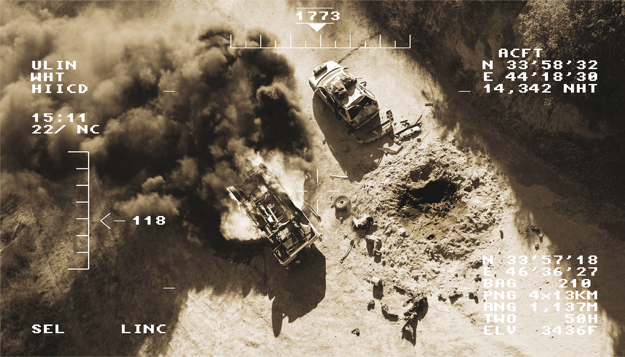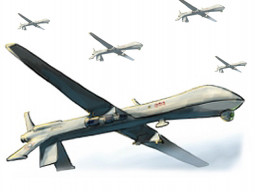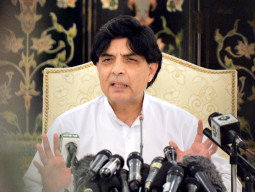
“This is the first time that I’ve had to talk to CNN about one of our exhibits,” quips Sarah Bevan, curator of the Imperial War Museum’s (London) IWM Contemporary programme, which features 5,000 Feet Is The Best, a short film by artist Omer Fast exploring the subject of drone warfare.
“At 5,000 feet,” explains a drone operator interviewed by Fast in the film, “I can tell what type of shoes you’re wearing from a mile away.” The film is structured around segments of interviews with this former drone operator (now employed as a security guard) who claims to be suffering from post-traumatic stress disorder (PTSD) as a consequence of the missions he has been a part of in Afghanistan and Pakistan. The film, played on a loop, has no discernable opening or ending, and viewers are free to watch the narrative, comprised of a series of vignettes, unfold at any point.
Born in Jerusalem, Fast currently lives in Berlin and describes himself as a news junkie but not a war artist. With this film, he explores how the use of drone technology has all but removed the sliver of a line distinguishing home from the battlefront in today’s conflicts. He does this through the stories of a man who, as he describes, “drives to work, punches in with a card, has a Starbucks coffee and then sits in front of a computer for several hours and engages in real-time combat.” With its slick production values, the film resembles a high-budget Hollywood film and also features actor Denis O’Hare who plays the vampire Russell Edgington on the popular TV show True Blood. The format is entirely familiar, thereby enabling us to suspend our disbelief as we watch an American family, on a road trip, incinerated in the sudden launch of a missile near their car, while also alluding to our routine consumption of violence through films and television and a 24-hour news cycle.

As Fast interviews the drone operator about the process of identifying targets, his camera takes us into the night sky above Las Vegas, where the operator’s base is located, the city a blinking, shimmering circuit of light. As Fast’s camera roves the city, the operator describes how it was night here in Vegas and day time there as he searched for IEDs in a town in Afghanistan. Eventually he finds a wannabe terrorist and sends out a laser targeting marker known to Marines as the light of God. The beacon of light visible through night vision goggles that looks like it is coming from heaven, pinpoints the location of a suspicious object or person in preparation for the launch of a missile. Caught up in the slow-paced, almost lulling footage of twinkling lights, you might miss the operator say, “I didn’t realise, oh hey, I just killed someone. It didn’t impact me.”
Q: What got you interested in the subject of drone warfare and surveillance?
Fast: There was a quote by Sandy Berger, who was a national security advisor to Clinton during his presidency, and at the time they had just watched the first drone mission take place. There’s this description in her book of this huge enthusiasm in the room from the people who have been watching what’s happened and she said something like, “Unfortunately, gentlemen, the light at the end of the tunnel is just another tunnel.” I thought that it was a smart and poetic way to look at something that is enthusiastically embraced by politicians and generals but whose implications are entirely unclear. Very often my interest or ideas will be something that come to me not from something I read, but in a less prepared state — I have an idea and sometimes it’s just an image. In this case, there was the image of these unseen faces who are working this technology, working these weapons.

The film addresses certain preconceptions we have about war — that we take young men, dress them up, give them pieces of machinery or armor, we ship them off somewhere and they fight in our name on some exotic, foreign soil and then they will come back to us. That notion is highly problematic and it has become even more problematised with the introduction of drone warfare. The film addresses a collapsing of certain conventions about warfare and our encounter with other cultures and this increasingly fetishised investment in technology as something that is going to save us, that will augment us to such a degree that will give us the power of the Gods.
Q: How did you go about getting in touch with the people who work as drone operators?
Fast: I live in Berlin and the producer of this piece, Daniel, lives in Los Angeles. I first put forward an application to the Pentagon to interview these people and Daniel and I were very aware that this permission was not going to be granted, so we pursued alternative tracks. We found out that the base where these operators work is located outside of Las Vegas and so we put up an ad in Craigslist in Vegas. Within days we had a lot of hits. I met two guys who responded to our ad and who turned out to be completely crazy — they had full-blown fantasies about this line of work. One even claimed to be working in drone technology during its infancy.
We had published the ad with a pseudonym and made up an email address but Daniel then received a phone call from the FBI — they had tracked his phone number through the IP address used to publish the ad. At that point all the contacts we had that seemed to be legitimate and people who were still in the program, who were interested in talking to us went completely silent. But the one person who continued dealing with us had just left the programme several months ago and he felt comfortable speaking with us. We arranged to meet him in Las Vegas. However he was very cautious and paranoid about what he could talk about. I did send him the film but I never heard back, I don’t know if he’s seen it or what he thinks of it.
Q: Can you talk about the format of the film and the decision to mix conventions from various genres?
Fast: There is a documentary component to the piece and I use that word carefully. The overall structure depends on relatively long segments of interview with this drone sensor operator who talks about his work and some of his missions and what he claims to be the post traumatic stress that he experiences. His face, when he does appear on camera, is blurred, as we were concerned about his identity. We tried to find ways of tying those interview segments together and connecting them to his state of mind while also acknowledging the circumstances of the interview. Interruptions like the FBI calling us and bothering us or not being sure whether we would be stopped or arrested or any of these things which in retrospect seem silly or fanciful [now] but created a pretty paranoid situation [at the time]. My conversation with the drone operator was interrupted repeatedly as he said we couldn’t use something he had just said or wanted to end the interview. Some of our conversations would take place in the hotel corridor because the camera was not there. So the work tries to address some of the information gained off-camera by including it in fictional reenactments. The film is screened on a loop, with no one point of beginning or ending, in order to address the conceptual issue of somebody who claims to be suffering quite a bit. He has symptoms like loss of sleep and nightmares and so on. And to get into his state of mind, the piece is structured or narrated as a hallucinatory, never-ending, loopy story where somebody is constantly retelling the same story, trying to escape or leave but is unable to.
Q: Do you ever feel the burden of translating someone else’s experience, particularly the experience of those living in areas under drone surveillance or attacks, for a piece like this?
Fast: Yes absolutely, that’s the sticky core of the work. I don’t think that for the type of work that I do, I need to answer to the kind of criteria that a journalist would. The work is not didactic; the point is not to explain to people what the day in a life of a drone sensor operator is. I’m going into this guy’s head and that’s where the focus is. The piece acknowledges the limits of its focus by casting his victims as North Americans. Anybody watching this who has any understanding of what is going on knows that those people aren’t the targets of drones, at least not yet.
The work also reflects, to a great extent, what this drone does. It puts you at such a remove from the places and people that you’re targeting and killing that [you are] separated from any kind of understanding of another context or culture or situation. Don’t forget — this person wakes up, has his muffins or cereal, gets in a car, stops at Starbucks on the way, gets a latte, listens to heavy metal in his car, he’s surrounded by Americans, he is nowhere near where this drone is flying. He is half a world away from it. And within a few hours he could be impacting another part of the world in the most radical way possible and then he goes back to work and picks up his laundry or goes out on a date and as he says in the piece, after several years, he begins to feel that what he is doing is quite a lot more complicated and more demanding on him psychologically than he would have thought in the beginning.
Sanam Maher is a Karachi-based writer.
Published in The Express Tribune, Sunday Magazine, November 24th, 2013.


































































COMMENTS
Comments are moderated and generally will be posted if they are on-topic and not abusive.
For more information, please see our Comments FAQ